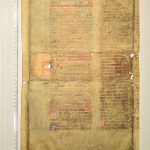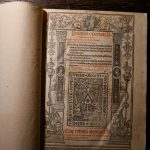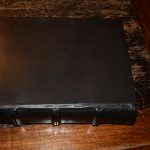Three fragments of the Pauline Library of the Central Seminary (F 697, 698, 699) and a fragment of the University Library (F 813) come from the same codex, a 15th-century notated breviary from Bohemia. In two of the carrier books of the four related fragments (F 813, F 699) we find the ownership record of the Jesuit college in Pozsony (Bratislava) dated 1692. The carrier of F 813 contains also the name of another owner, Daniel Schmid. Schmid’s name appears also in the carrier book of the third fragment (F 698), which, however, does not contain the entry of the Pozsony Jesuits. However, we know about Daniel Schmid that he also worked in Pozsony as a Lutheran pastor from 1636, and several of his books bearing his name have been preserved in the collections of both the University and the Pauline Library (Fr. l. m. 106 in the University Library; Fr. l. m. 17, 79, 115 = F 845, 192 in the Pauline Library). Both the possessor entries and the common mother codex of the fragments serving as covers indicate that the books were bound in Pozsony, and that the bookbinder used for his work the parchment leaves of the Bohemian notated breviary. More on Daniel Schmid, see: Zsuzsa Czagány, “Music manuscript fragments with Bohemian notation in the Pauline Library of the Central Seminary in Budapest”, Magyar Egyházzene XXV (2021/2022) No. 1, 77–104; More to the carrier books owned by the Pozsony Jesuit college and the codex fragments surviving as their bindings, see: Edit Madas, „Beiträge zur Provenienz einer Fragmentengruppe der Bibliothek des Zentralseminars zu Budapest”, Ars Hungarica, 17 (1989), 47-50.
The fragment preserved three responsories of Matins of the Office for St. Clement, and its complete Lauds and Vespers. The selection of chants is almost completely identical to the practice of mediaeval Bohemian sources: the three responsories – as the proper of the Office – in this disposition stands in the third Nocturne, the material of the first two Nocturnes was borrowed from the commune sanctorum (Zsuzsa Czagány, Corpus Antiphonalium Officii Ecclesiarum Centralis Europae III/B Praha, Sanctorale, Commune Sanctorum, Budapest: Institute for Musicology of the Hungarian Academy of Sciences, 2002) 169-170, 185). The only unusual element of the Laud’s antiphon cycle is the ant. nr. 5 Invenerunt in modum, instead of the more common ant. Omnes gentes per gyrum. The ant. Invenerunt is unknown in the central Prague Office tradition. It only appears in two early Benedictine breviaries, but in a different liturgical function (in the 12th century breviary of the St. George’s Benedictine Convent in Prague: http://cantusbohemiae.cz/source/2152, and in a manuscript of the Benedictines of Rajhrad from the same period: http://cantusbohemiae.cz/source/2150). On the other hand, the antiphon occurs in large numbers in sources of the South-German – Austrian region.
Zsuzsa Czagány





